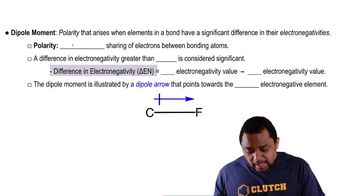Textbook Question
Explain why CO2 and CCl4 are both nonpolar even though they contain polar bonds.
 Tro 6th Edition
Tro 6th Edition Ch.11 - Chemical Bonding II: Molecular Shapes, VSEPR & MO Theory
Ch.11 - Chemical Bonding II: Molecular Shapes, VSEPR & MO Theory Problem 50
Problem 50 Verified step by step guidance
Verified step by step guidance



Explain why CO2 and CCl4 are both nonpolar even though they contain polar bonds.
CH3F is a polar molecule, even though the tetrahedral geometry often leads to nonpolar molecules. Explain.
Determine whether each molecule in Exercise 35 is polar or nonpolar.
a. CI4
b. NCl3
c. OF2
d. H2S
Determine whether each molecule is polar or nonpolar. b. SiCl4
Determine whether each molecule is polar or nonpolar. c. SeCl6
Determine whether each molecule is polar or nonpolar.
a. IF5
b. SCl2
c. SCl4
d. BrF5